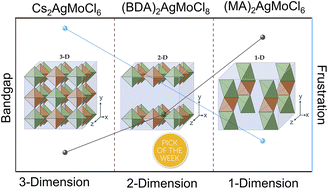Molybdenum chloride double perovskites: dimensionality control of optical and magnetic properties†
Abstract
Halide double perovskites are a promising class of semiconducting materials for applications in solar cells and other optoelectronic devices. Recently, there has been a surge of interest in these materials to study phenomena beyond optoelectronics, especially magnetism. Here, we report three new Mo3+ (4d3) based chloride double perovskites: a 3-D rock-salt ordered Cs2NaMoCl6, a 1-D chain (MA)2AgMoCl6 and a Dion–Jacobson type 2-D layered (1,4-BDA)2AgMoCl8 (MA = methylammonium; 1,4-BDA = 1,4-butanediammonium). Their structures and dimensionalities can be tuned by means of the A-cation. The measured bandgaps are relatively narrow (2.0–2.1 eV) which show a blueshift on reducing the dimensionality. At low temperatures, we observe antiferromagnetic coupling between the nearest-neighbour Mo3+ ions in all these systems. Cs2NaMoCl6 shows stronger coupling with a frustration index f of 5 which we attribute to the geometrically frustrating fcc lattice of Mo3+ ions. This work expands the scope of halide double perovskites beyond main group metals and beyond optoelectronics, and we hope that it will lead to future developments in magnetic halide perovskites.

- This article is part of the themed collections: 2023 Chemical Science HOT Article Collection, #MyFirstChemSci 2023 and 2023 ChemSci Pick of the Week Collection


 Please wait while we load your content...
Please wait while we load your content...